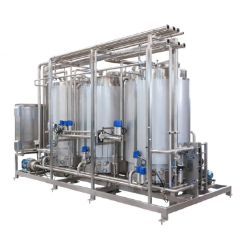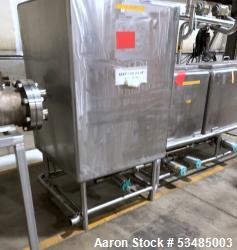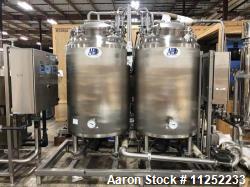Used Clean In Place - CIP Systems
Aaron Equipment has an inventory of reconditioned, unused, and used clean-in-place (CIP) systems. Clean-in-Place (CIP) equipment refers to a system used for cleaning the interior surfaces of pipes, tanks, vessels, and other process equipment without disassembling or removing them. CIP systems are widely used in industries like food and beverage, pharmaceuticals, biotechnology, dairy, and cosmetics, where maintaining high standards of hygiene and sanitation is crucial. A typical CIP process involves circulating cleaning solutions (such as water, detergents, or sanitizers) through a set of pipes, tanks, and equipment. Clean-in-Place (CIP) equipment is an essential part of industries where hygiene and cleanliness are critical. These systems automate the cleaning process, improving efficiency, consistency, and safety while minimizing labor and downtime. If you are looking to sell your used clean in place systems submit a request online or contact Erik Eichert at 630-238-7480.
Maintaining cleanliness and hygiene is crucial in today's industrial world, especially in food and beverage, pharmaceuticals, and chemicals. Industrial clean-in-place (CIP) machines play a vital role in ensuring the cleanliness of processing equipment without disassembling it. This guide will help you understand CIP machines, their work, and why they are essential for sanitary processing.
What Are Industrial Clean-In-Place Machines?
Industrial clean-in-place machines are automated cleaning systems designed to clean the interior surfaces of pipes, vessels, equipment, and filters in an industrial setting. They are widely used in industries that require stringent hygiene standards, such as food processing, dairy, and pharmaceuticals.
The Purpose of CIP Machines
The primary purpose of CIP machines is to ensure that processing equipment remains sanitary and contamination-free. This is achieved by flushing cleaning solutions through the equipment, removing residues, and sanitizing surfaces without dismantling the machinery. CIP systems are vital for maintaining product quality, ensuring compliance with health regulations, and reducing the risk of contamination.
How Do CIP Machines Work?
CIP machines follow a systematic process to clean and sanitize equipment. The process typically involves several stages designed to address different cleaning needs.
The CIP Cleaning Process
- Pre-rinse: The first step involves flushing the equipment with water to remove loose particles and residues, which prepares it for the cleaning solution.
- Detergent Wash: A detergent solution is circulated through the equipment to dissolve and remove fats, proteins, and other soils. The choice of detergent depends on the type of residues present and the material of the equipment.
- Post-rinse: After the detergent wash, the equipment is rinsed with water to remove any remaining cleaning solution and residues.
- Sanitization: A sanitizing agent kills bacteria and other microorganisms, ensuring the equipment is free from harmful pathogens.
- Final Rinse: A final rinse with water removes any residual sanitizing agent, leaving the equipment ready for the next production cycle.
The Benefits of Using CIP Machines
CIP systems offer several advantages over traditional cleaning methods:
- Efficiency: Automated cleaning allows faster and more consistent cleaning cycles than manual methods.
- Consistency: CIP machines provide consistent cleanliness, reducing the risk of contamination and ensuring product quality.
- Safety: CIP systems reduce the risk of accidents and workers' exposure to cleaning chemicals by eliminating the need to disassemble equipment.
- Cost-Effectiveness: While the initial investment in CIP systems can be high, they save time and labor costs in the long run by automating the cleaning process.
Types Of CIP Systems
CIP systems can be categorized into different types based on design and functionality.
Single-Use vs. Reuse CIP Systems
- Single-Use CIP Systems: These systems use fresh cleaning solutions for each cleaning cycle, ensuring high levels of hygiene. They are commonly used in industries with strict sanitary requirements.
- Reuse CIP Systems: These systems recycle cleaning solutions for multiple cleaning cycles, reducing water and chemical usage. They are cost-effective and environmentally friendly but may not be suitable for all applications.
Automated vs. Manual CIP Systems
- Automated CIP Systems: These systems are fully automated, with programmable controllers managing the cleaning process. They offer high efficiency and consistency.
- Manual CIP Systems: These systems require manual intervention at various stages of the cleaning process. They are less expensive but may not provide the same level of consistency as automated systems.
Choosing The Right CIP System
Selecting the right CIP system for your operation depends on several factors, including the type of industry, the nature of the residues, and your budget.
Key Considerations
- Industry Requirements: Different industries have varying hygiene standards. Ensure that the CIP system you choose meets your industry's regulatory requirements.
- Type of Residues: The nature of the residues present will determine the kind of cleaning solutions and the design of the CIP system.
- Budget: Consider the initial investment and the long-term operational costs when selecting a CIP system.
- Scalability: Choose a system that can be easily scaled to accommodate changes in production volume.
Maintenance and Troubleshooting
Regular maintenance and troubleshooting are essential to ensure the optimal performance of CIP systems.
- Maintenance Tips
- Regular Inspections: Regularly inspect the CIP system to identify any signs of wear and tear or malfunction.
- Calibration: Ensure the system's sensors and controls are calibrated regularly for accurate performance.
- Cleaning Solution Management: Monitor the concentration and effectiveness of cleaning solutions to ensure efficient cleaning.
- Common Issues and Solutions
- Inadequate Cleaning: If the equipment is not being cleaned thoroughly, check the concentration and temperature of the cleaning solutions.
- Equipment Corrosion: Use the appropriate cleaning solutions and materials to prevent corrosion of equipment surfaces.
- System Blockages: Regularly inspect and clean filters and nozzles to prevent blockages in the system.
Top Clean-In-Place System Brands
While there are many reputable manufacturers, the market has shown a preference for the following brands:
- Alfa Laval, GEA Group, SPX FLOW, Tetra Pak, Sani-Matic and many more.
Industrial clean-in-place machines (CIPs) are essential for maintaining hygiene and efficiency in industries with stringent sanitary requirements. By understanding the basics of CIP systems, you can select the right system for your needs, ensuring that your equipment remains clean, safe, and ready for production. With the right CIP system, you can enhance product quality, comply with industry regulations, and optimize your cleaning processes.


